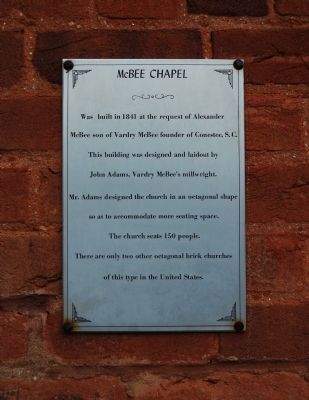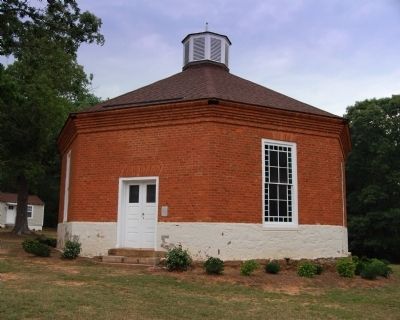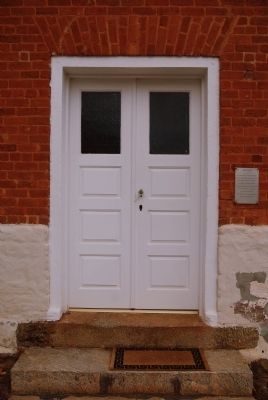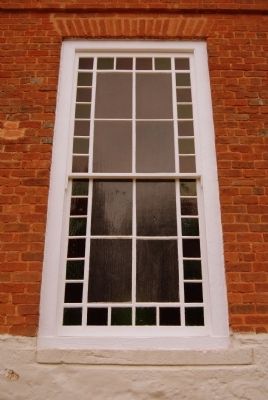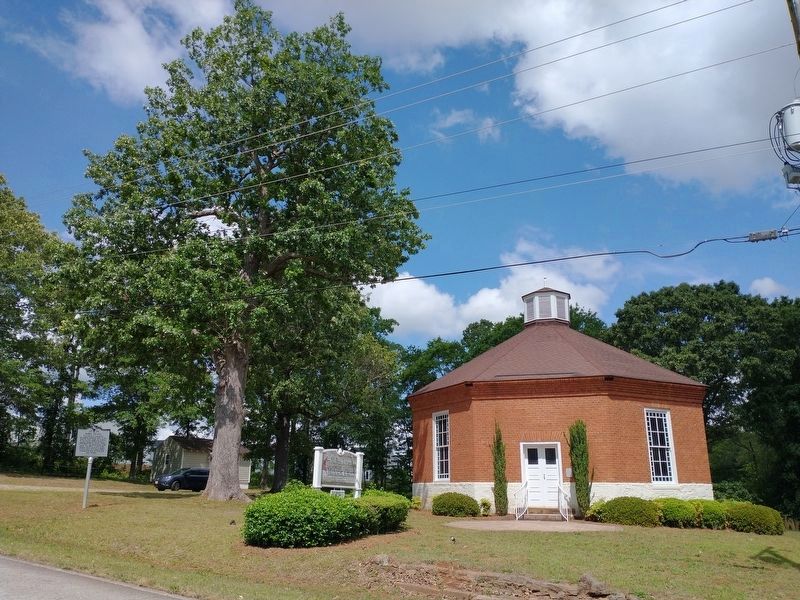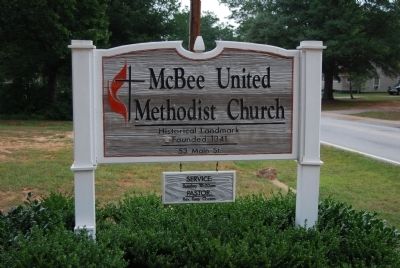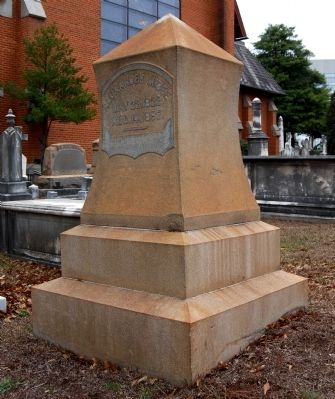Conestee in Greenville County, South Carolina — The American South (South Atlantic)
McBee Chapel
McBee son of Vardry McBee founder of Conestee, S.C.
This building was designed and laidout by
John Adams, Vardry McBee's millwright.
Mr. Adams designed the church in an octagonal shape
so as to accommodate more seating space.
The church seats 150 people.
There are only two other octagonal brick churches
of this type in the United States.
Topics and series. This historical marker is listed in this topic list: Churches & Religion. In addition, it is included in the Former U.S. Presidents: #02 John Adams series list. A significant historical year for this entry is 1841.
Location. 34° 45.97′ N, 82° 21.202′ W. Marker is in Conestee, South Carolina, in Greenville County. Marker is on Main Street, on the right when traveling south. Marker is to the right of the church building's main entrance. Touch for map. Marker is at or near this postal address: 53 Main Street, Greenville SC 29605, United States of America. Touch for directions.
Other nearby markers. At least 10 other markers are within 4 miles of this marker, measured as the crow flies. McBee Chapel / McBee Methodist Church (a few steps from this marker); Reedy River Factory (approx. 0.4 miles away); Lake Conestee in Transition (approx. 0.7 miles away); Beaver at Lake Conestee (approx. 0.7 miles away); Donaldson Air Force Base / Captain John O. Donaldson (approx. one mile away); a different marker also named Donaldson Air Force Base / Captain John O. Donaldson (approx. 1.8 miles away); Mauldin United Methodist Church (approx. 2.8 miles away); The History of the Gosnell Cabin (approx. 2.8 miles away); Mauldin (approx. 2.9 miles away); Laurel Creek Church (approx. 3.1 miles away). Touch for a list and map of all markers in Conestee.
Also see . . .
1. McBee Methodist Church. South Carolina Department of Archives and History Website entry:
Architecturally unique, McBee Methodist Church was designed ca. 1842 by John Adams, a local wheelwright who felt that more seating space could be secured by an octagonal arrangement. (Submitted on September 16, 2008, by Brian Scott of Anderson, South Carolina.)
2. McBee Methodist Church (Conestee, South Carolina). Wikipedia entry:
McBee Methodist Church, also known as McBee Chapel, is an historic octagonal-shaped yellow brick Methodist church building located on Main street in Conestee, Greenville County, South Carolina. (Submitted on February 1, 2009, by Brian Scott of Anderson, South Carolina.)
3. Lake Conestee Nature Park. Park Website homepage:
Lake Conestee Nature Park consists of approximately 400 acres of beautiful natural habitat on the Reedy River just 6 miles south of downtown Greenville, South Carolina. (Submitted on February 1, 2009, by Brian Scott of Anderson, South Carolina.)
Additional commentary.
1. McBee Methodist Church (McBee Chapel) - National Register Nomination Form
Eight sided brick structure with pyramidal asphalt shingled roof of soft green topped by white octagonal louvered cupola; molded brick cornice; whitewash around base sets off random brick exterior.
Brickwork broken by six windows and white four panel double front door (top panel glass); original wooden pegs that bind casings still visible; seating capacity 150.
Church situated on slight knoll with few shad trees on front and sides.
Interior has soft cream and buff shards; brightened by beige carpeting with colorful stripe; a bell rope extends down into center of structure; bell rung each Sunday.
Semicircular altar rail, altar table, pulpit, and pulpit furnishings painted soft bluff; gas heaters provide heat in winter.
Significance
Architecturally unique, McBee Methodist Church was designed by John Adams, a local wheelwright who felt that more seating space could be secured by an octagonal arrangement.
The little structure is a fine example of octagonal architecture in vogue in the United States from the 1840s – 1860s; its prime advantage being that it encloses one-fifth more floor area than a square with the same total length of the wall. In addition, octagonal design offered a new aesthetic dimension to American architecture at this time.
Because the funds for the little church, still in use, were provided by Vardry McBee, born in Lincolnton, North Carolina and called “The Father of Greenville,” the church was named for him. For more than half a century, McBee played a leading and generous role in developing Greenville industrially and commercially; donating lands and funds for the first churches and schools in the Greenville area.
Throughout its 130 year existence, the church has served as a meeting place for many organizations and civic discussions. Local tradition holds that the church was a rallying point for induction into the army during the Confederate War.
— Submitted July 25, 2009, by Brian Scott of Anderson, South Carolina.
2. Vardry McBee
Vardry McBee was perhaps the most pivotal figure in the history of our city and Greenville County as a whole. thanks to his business acumen and impressive foresight for how the community could grow and prosper.
A product of the Carolina frontier, McBee was born in 1775 on the eve of the American Revolution, a conflict that would prove formative in his early years. Both his father and older brother fought with the Patriots, at King's Mountain and the Battle of Cowpens. McBee himself never fought for American independence, but instead used his considerable fortune to improve the lives of his fellow citizens, appropriating his land and fortunes to public projects.
McBee opened the first textile mill on the Reedy River, but he saw value in a diversified economy. In his private business life, that meant he owned two flour mills, a cotton factory, and wool and paper mills. Publicly, even as he approached his 80s, it led him to champion the construction of a railroad line that connected Columbia and Greenville. In 1853, this line became the first rail to serve the community, and it would eventually become a turning point in the economy of the town. (Source: G: The Magazine of Greenville, Jan/Feb 09, pg 66.)
— Submitted July 25, 2009, by Brian Scott of Anderson, South Carolina.
Credits. This page was last revised on May 23, 2022. It was originally submitted on July 20, 2008, by Brian Scott of Anderson, South Carolina. This page has been viewed 3,101 times since then and 36 times this year. Last updated on July 21, 2008, by Brian Scott of Anderson, South Carolina. Photos: 1, 2. submitted on July 20, 2008, by Brian Scott of Anderson, South Carolina. 3, 4. submitted on July 21, 2008, by Brian Scott of Anderson, South Carolina. 5. submitted on May 21, 2022, by Tom Bosse of Jefferson City, Tennessee. 6. submitted on July 20, 2008, by Brian Scott of Anderson, South Carolina. 7. submitted on February 1, 2009, by Brian Scott of Anderson, South Carolina. • Craig Swain was the editor who published this page.
